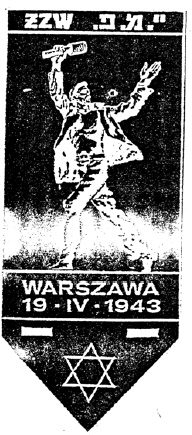Jewish military association
The Jewish Military Association (pl. Żydowski Związek Wojskowy , short ŻZW) was a resistance organization in the Warsaw ghetto . It was founded in November 1939.
The ŻZW consisted mainly of right-wing Zionists and a group of former members of the Polish Army who had fought against the Germans in September 1939. The ŻZW was organized independently of the politically left-wing Jewish Fighting Organization (ŻOB). The number of members is estimated at between 200 and 250, who, due to their comparatively good contacts with the Polish underground, were much better armed than the fighters of the OOB, for example. During the uprising in the Warsaw ghetto , they fought with the OOB against the German occupiers . After most of the members were killed, the survivors fled the ghetto in early May 1943 .
In recent years, an Israeli-Polish research team ( Dariusz Libionka and Laurence Weinbaum) has verified the truthfulness of the memories and some statements on the subject of the Jewish Military Association by Henryk Iwański , Kalman Mendelson , Tadeusz Bednarczyk , Jack Eisner, David J. Landau, Maurice Shainberg, Joseph Greenblatt and other people declared questionable. The two historians also raise the question of whether Dawid Moryc Apfelbaum was not a fictional character and whether the “Kontaktring”, the most striking relic of the ŻZW (which is on display in Yad Vashem ), is not a forgery. In doing so, the two of them put the correctness of literature above the uprising as v. a. was shaped by Marian Apfelbaum, Maciej Kledzik and Moshe Arens , is generally in question.
Individual evidence
- ↑ Shoah Resource Center, Jewish Military Union, Warsaw online PDF
- ↑ Dariusz Libionka and Laurence Weinbaum: Bohaterowie, hochsztaplerzy, opisywacze - Wokół Żydowskiego Związku Wojskowego. Stowarzyszenie Centrum Badań nad Zagładą Żydów, Warsaw 2011.
- ↑ Tadeusz Bednarczyk: Obowiązek silniejszy od śmierci: wspomnienia z lat 1939-1944 o polskiej pomocy dla Żydów w Warszawie , Wyd. Grunwald, Warsaw 1986.
- ↑ Jack Eisner: The Survivor. Wiliiam Morrow , New York 1982.
- ^ David J. Landau: Caged: A Story of Jewish Resistance. Pan Macmillan Australia, Melbourne 2000.
- ^ Maurice Shainberg: Breaking from the KGB: Warsaw Ghetto Fighter ... Intelligence Officer ... Defector to the West. Shapolsky, New York 1986.
- ↑ Dariusz Libionka and Laurence Weinbaum: "A Legendary Commander" - Haaretz, June 22, 2007.
- ↑ Marian Apfelbaum: Retour sur le ghetto de Varsovie. Odile Jacob, Paris 2002.
- ↑ Maciej Kledzik: Zapomniani Żołnierze ZZW. - Rzeczpospolita, April 18, 2008.
- ^ Moshe Arens: "The Warsaw ghetto uprising; a reappraisal", Yad Vashem Studies 33 (2005); "The Jewish Military Organization (ŻZW) in the Warsaw Ghetto", Journal of Holocaust and Genocide Studies, 1, 2 (2005); "The Development of the Narrative of the Warsaw Ghetto Uprising", Israel Affairs 14, 1 (2008)
literature
- Dariusz Libionka, Laurence Weinbaum: Deconstructing Memory and History: The Jewish Military Union (ZZW) and the Warsaw Ghetto Uprising online at jcpa.org
